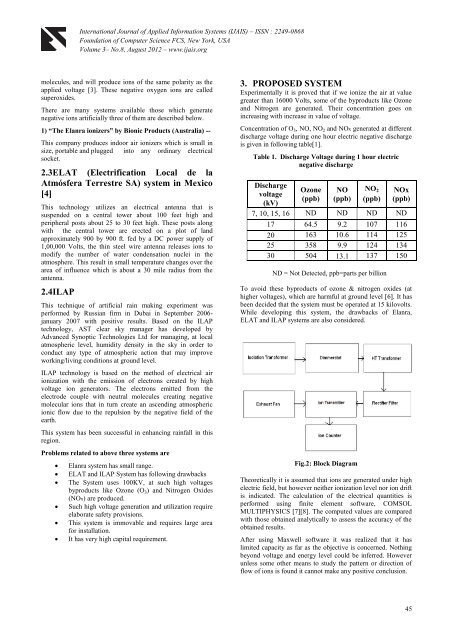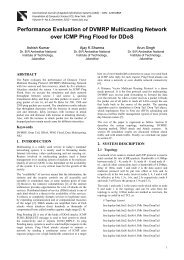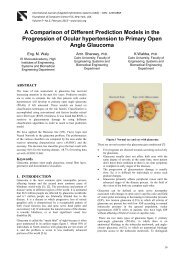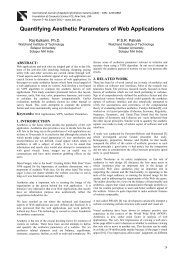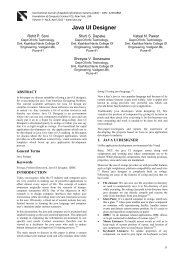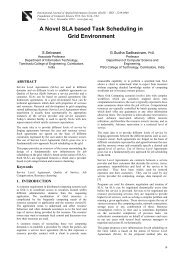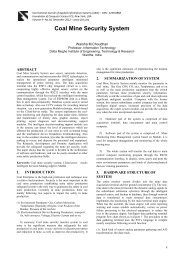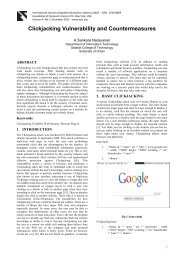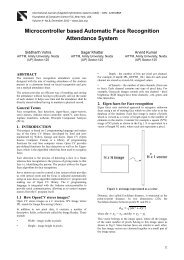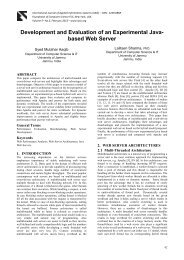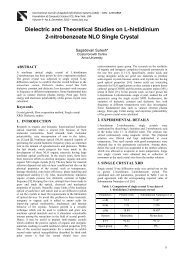Proposed Negative Ion Generator - International Journal of Applied ...
Proposed Negative Ion Generator - International Journal of Applied ...
Proposed Negative Ion Generator - International Journal of Applied ...
You also want an ePaper? Increase the reach of your titles
YUMPU automatically turns print PDFs into web optimized ePapers that Google loves.
<strong>International</strong> <strong>Journal</strong> <strong>of</strong> <strong>Applied</strong> Information Systems (IJAIS) – ISSN : 2249-0868<br />
Foundation <strong>of</strong> Computer Science FCS, New York, USA<br />
Volume 3– No.8, August 2012 – www.ijais.org<br />
molecules, and will produce ions <strong>of</strong> the same polarity as the<br />
applied voltage [3]. These negative oxygen ions are called<br />
superoxides.<br />
There are many systems available those which generate<br />
negative ions artificially three <strong>of</strong> them are described below.<br />
1) “The Elanra ionizers” by Bionic Products (Australia) --<br />
This company produces indoor air ionizers which is small in<br />
size, portable and plugged into any ordinary electrical<br />
socket.<br />
2.3ELAT (Electrification Local de la<br />
Atmósfera Terrestre SA) system in Mexico<br />
[4]<br />
This technology utilizes an electrical antenna that is<br />
suspended on a central tower about 100 feet high and<br />
peripheral posts about 25 to 30 feet high. These posts along<br />
with the central tower are erected on a plot <strong>of</strong> land<br />
approximately 900 by 900 ft. fed by a DC power supply <strong>of</strong><br />
1,00,000 Volts, the thin steel wire antenna releases ions to<br />
modify the number <strong>of</strong> water condensation nuclei in the<br />
atmosphere. This result in small temperature changes over the<br />
area <strong>of</strong> influence which is about a 30 mile radius from the<br />
antenna.<br />
2.4ILAP<br />
This technique <strong>of</strong> artificial rain making experiment was<br />
performed by Russian firm in Dubai in September 2006january<br />
2007 with positive results. Based on the ILAP<br />
technology, AST clear sky manager has developed by<br />
Advanced Synoptic Technologies Ltd for managing, at local<br />
atmospheric level, humidity density in the sky in order to<br />
conduct any type <strong>of</strong> atmospheric action that may improve<br />
working/living conditions at ground level.<br />
ILAP technology is based on the method <strong>of</strong> electrical air<br />
ionization with the emission <strong>of</strong> electrons created by high<br />
voltage ion generators. The electrons emitted from the<br />
electrode couple with neutral molecules creating negative<br />
molecular ions that in turn create an ascending atmospheric<br />
ionic flow due to the repulsion by the negative field <strong>of</strong> the<br />
earth.<br />
This system has been successful in enhancing rainfall in this<br />
region.<br />
Problems related to above three systems are<br />
� Elanra system has small range.<br />
� ELAT and ILAP System has following drawbacks<br />
� The System uses 100KV, at such high voltages<br />
byproducts like Ozone (O 3) and Nitrogen Oxides<br />
(NOx) are produced.<br />
� Such high voltage generation and utilization require<br />
elaborate safety provisions.<br />
� This system is immovable and requires large area<br />
for installation.<br />
� It has very high capital requirement.<br />
3. PROPOSED SYSTEM<br />
Experimentally it is proved that if we ionize the air at value<br />
greater than 16000 Volts, some <strong>of</strong> the byproducts like Ozone<br />
and Nitrogen are generated. Their concentration goes on<br />
increasing with increase in value <strong>of</strong> voltage.<br />
Concentration <strong>of</strong> O 3, NO, NO 2 and NOx generated at different<br />
discharge voltage during one hour electric negative discharge<br />
is given in following table[1].<br />
Table 1. Discharge Voltage during 1 hour electric<br />
negative discharge<br />
Discharge<br />
voltage<br />
(kV)<br />
Ozone<br />
(ppb)<br />
NO<br />
(ppb)<br />
ND = Not Detected, ppb=parts per billion<br />
To avoid these byproducts <strong>of</strong> ozone & nitrogen oxides (at<br />
higher voltages), which are harmful at ground level [6]. It has<br />
been decided that the system must be operated at 15 kilovolts.<br />
While developing this system, the drawbacks <strong>of</strong> Elanra,<br />
ELAT and ILAP systems are also considered.<br />
Fig.2: Block Diagram<br />
NO2<br />
(ppb)<br />
NOx<br />
(ppb)<br />
7, 10, 15, 16 ND ND ND ND<br />
17 64.5 9.2 107 116<br />
20 163 10.6 114 125<br />
25 358 9.9 124 134<br />
30 504 13.1 137 150<br />
Theoretically it is assumed that ions are generated under high<br />
electric field, but however neither ionization level nor ion drift<br />
is indicated. The calculation <strong>of</strong> the electrical quantities is<br />
performed using finite element s<strong>of</strong>tware, COMSOL<br />
MULTIPHYSICS [7][8]. The computed values are compared<br />
with those obtained analytically to assess the accuracy <strong>of</strong> the<br />
obtained results.<br />
After using Maxwell s<strong>of</strong>tware it was realized that it has<br />
limited capacity as far as the objective is concerned. Nothing<br />
beyond voltage and energy level could be inferred. However<br />
unless some other means to study the pattern or direction <strong>of</strong><br />
flow <strong>of</strong> ions is found it cannot make any positive conclusion.<br />
45


